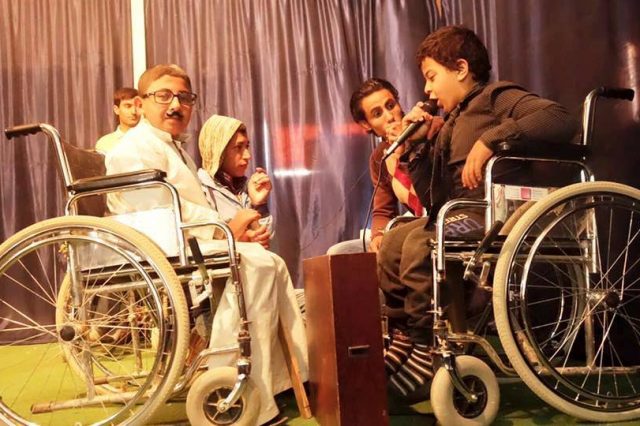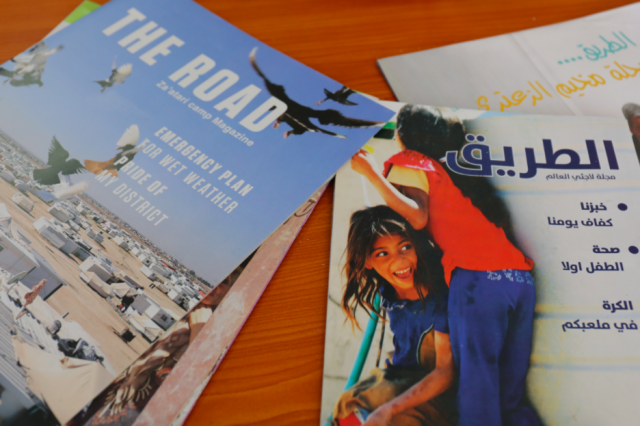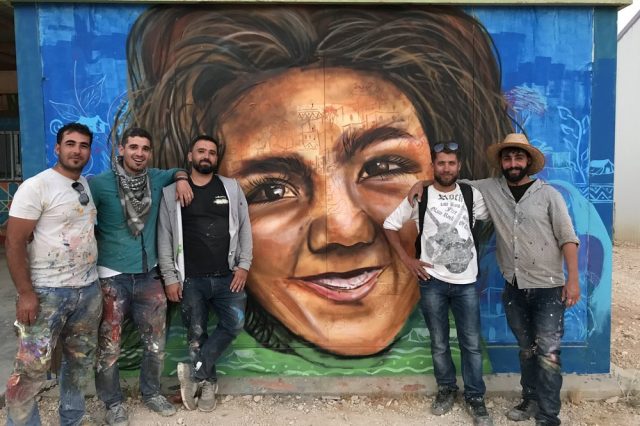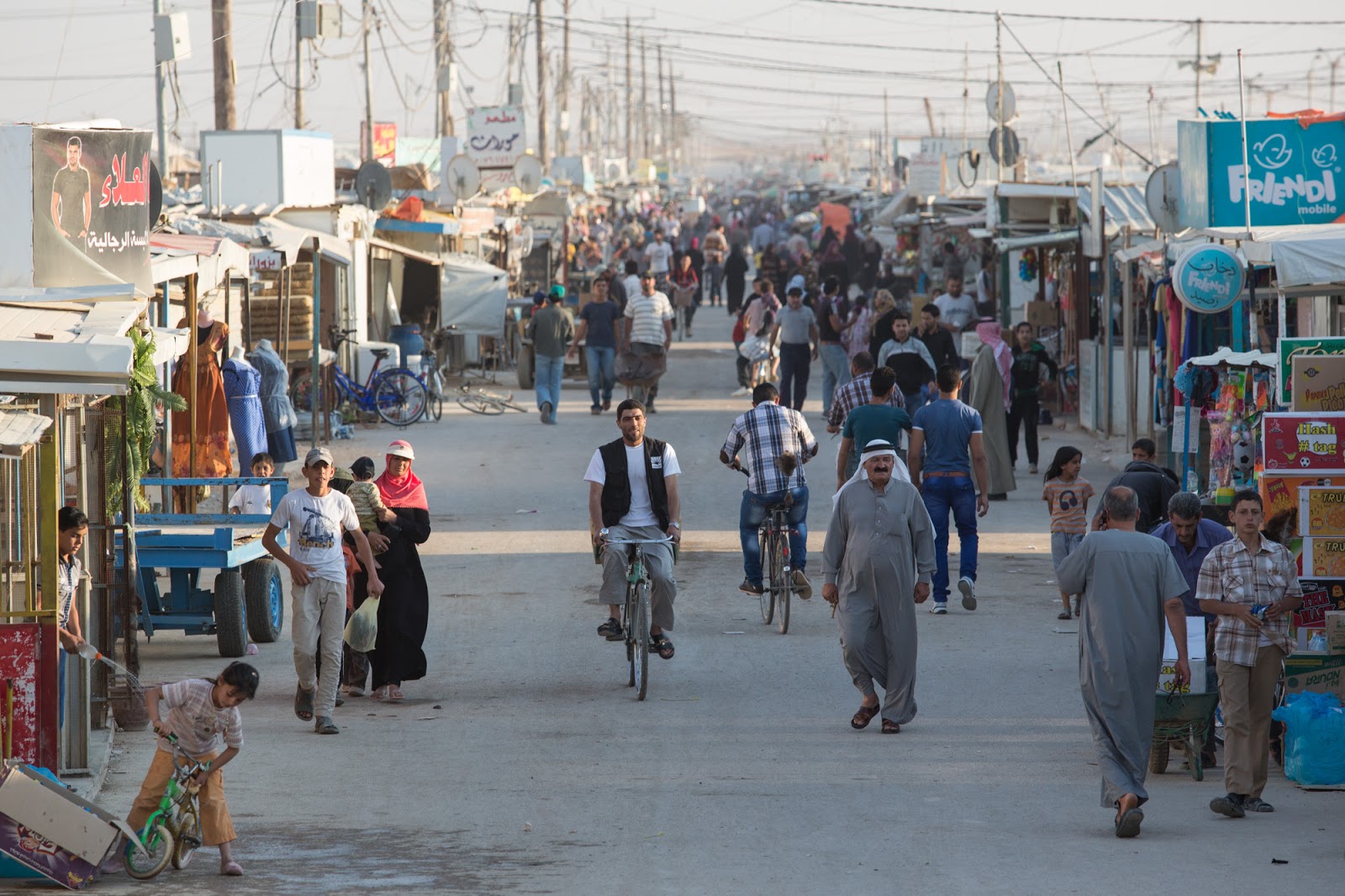Zaatari in Jordan, once a barren desert, has evolved into the fourth largest urban population in Jordan at 80,000. Basic services such as shelter, water, schooling, electricity and healthcare are provided by international agencies but Zaatari is like no other refugee camp. The Syrians, known for their entrepreneurialism, have transcended their hardships in innovative ways after hope of returning home have all but disappeared.
The camp residents have adapted to the harsh environment by re-using, re-shaping and upgrading available material. ‘Shams-Elysees’ (named after the Champs-Élysées in Paris and a pun on an alias name for Syria: `al-Sham’), the main commercial strip, has more than 3,000 Syrian-run stores, according to the UN Refugee Agency. The majority of shops are food related, ranging from sweet shops to pizza, but you can also find barber shops, beauty salons, phone repair shops, jewelry shops, foreign currency exchange, and essentially, whatever tickles your fancy! A walk through the vibrant street reveals a sense of normalcy; evidence of resilience of a people that have clearly persevered while going through immense hardships.
International agencies have also been working alongside Syrians on community-led projects and hand in hand have reshaped humanitarian relief in an unconventional way. Here are a few of the many entrepreneurs that have popped up paving the way to opportunities.
Reuse, reduce, & recycle
Oftentimes, when a person has lost everything and is in a protracted crisis situation, it is difficult to think creatively. That is not the case with the Zaatari camp residents. They have surprised many with their resourcefulness and ability to maximize on scarce materials available to them and adapting them for their specific needs. In a refugee camp setting, where demand for resources vastly outweighs supply, waste efficiency is critical.
Prefabricated shelters made of corroborated metal and tents made of canvas have been reshaped and re-used: Homes have been rebuilt with unique features such as courtyards and fountains to resemble Damascene architecture and an Oxfam livelihood programme trained 130 Syrian Women in the camp vocational training on tailoring. They are now able to re-use the tents they lived in when they first moved to the camp, converting them into bags.
“This project helped me tell my story, these bags are an expression of my own hardships,” explained Rula, a refugee from Zaatari who makes bags from old tent material.

Inclusive Theatre Troupe
Hamzah Hussein, also known as Abu Hamzah, 24 years old, established a theatre company called ‘Mark of Hope’ for refugee children with disabilities and has produced numerous plays. Having a mobility impairment himself, he feels strongly about his initiative and wanted to contribute in a meaningful way to the community. The Mark of Hope aims to “change the attitudes of society towards persons with disability – toward the importance of inclusion, contribution and empowerment of every one; to instill hope that every person can play a positive role in society, and to end the isolation and exclusion of persons with disability.”

The Road, a magazine run by refugees
The Road, entirely written and designed by refugees, launched in 2014 with support from JEN (Japan Emergency NGO), the first of its kind in a refugee camp setting. Intended to serve as a source of news and entertainment for camp residents, The Road is also an attempt to contribute to the information systems in the camp. The monthly publication features success stories from the residents, as well as handy advice on adjusting to camp life. Not only that, but 150 residents have been trained on journalism by a Jordanian professional journalist, a third of the participants women. 20,000 copies have been distributed thus far. “We know our own pain and want to tell our own stories,” explained one of the magazine’s staff.

Adding color and hope to the desert
The Jasmine Necklace, formed in 2016 by Syrian refugees residing in Zaatari camp as part of a Syrian artists’ collective, is a public art program empowering refugee children and adolescents by providing a safe platform for creative expression and trauma relief. Supported by various international agencies and in collaboration with Artolution and Joel Artista, the young artists paint colorful murals across the camp with different themes.
Joel Artista points out “the adult artists and educators continue to strive to uplift their community, never giving up on their hope for a brighter future.”

Agricultural innovation in what many believe to be a dusty, barren desert
Farming is not new to many in the camp, as many residents were previously residing in rural villages with some link to agriculture. While some sought to recreate familiar surroundings from their homes in Syria, simply soften the current reality, or turn a profit selling fresh produce, it is astonishing to see innovative irrigation with little resources in the harsh desert.
A few organizations have supported this green initiative, including Oxfam International, who has recently provided poly tunnels in order to grow cauliflower. Women, who make up over 50% of the camp population, helped in reaping the harvest. The Lemon Tree Trust also supports refugee communities’ green innovations through their projects with refugees in the camp. The co-founder believes that agriculture and cultivation create new and unrealised value for achieving dignity, empowerment and sovereignty for those living in under-resourced communities, like refugee camps.
The world’s largest solar powered camp
The largest solar plant to open in a refugee camp to date has had over 40,000 panels installed, resulting in reducing CO2 emissions by 13,000 tons per year and providing clean and safe energy to the camp. “Over 75 refugees worked alongside Jordanians in installing the solar panels and three Syrian refugee technicians are currently employed to support manage the plant,” said UNHCR Communications Officer, Marwa Hashem. Access to electricity has vastly improved since the launch.

Syrian refugees have proven to be incredibly resilient and adaptive in the face of what their future holds. With no end in sight to the conflict, Syrians are finding new ways to cope with their hardships.
“Syrian refugees are entrepreneurs by nature, many of them were working in trade before arrival to Jordan. Their skills in managing capital and trade has enabled many of them to both survive and thrive in the country of refuge.” -Irene Omondi, UNHCR Zaatari Camp Manager.
This article originally appeared on 1 Journey Festival, and has been reprinted with permission.
Photo: Jordi Matas/UNHCR

